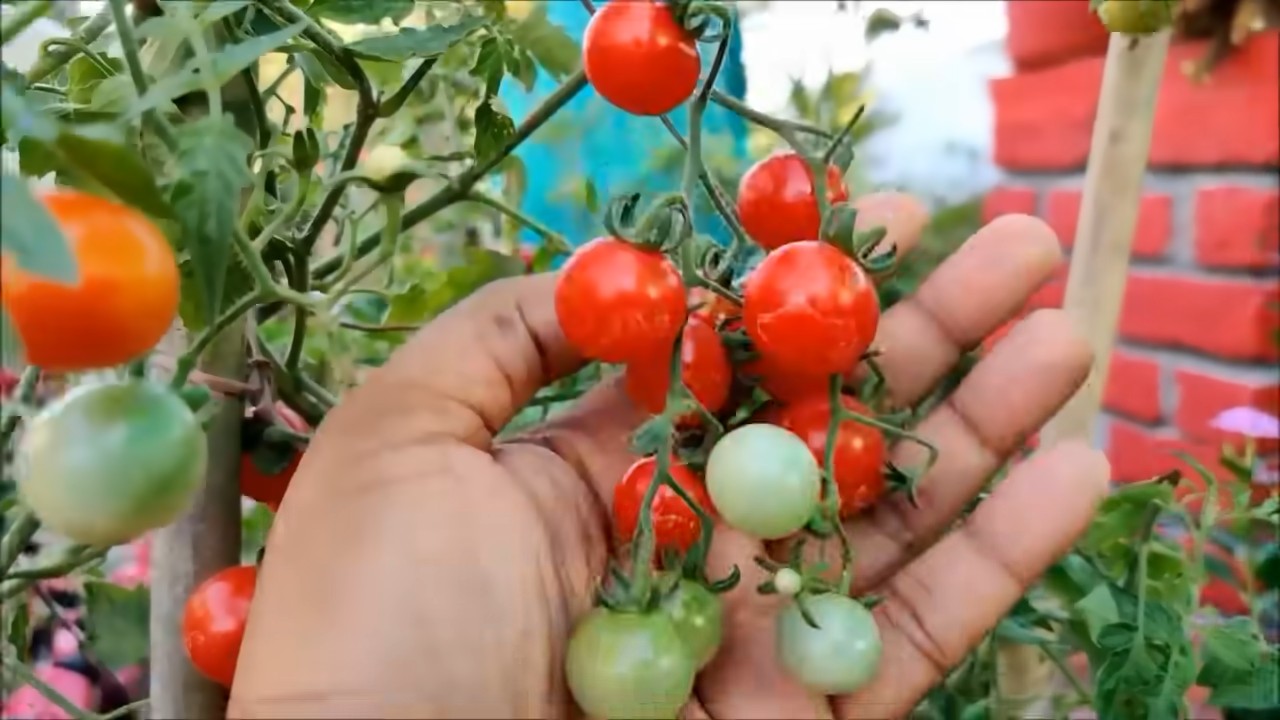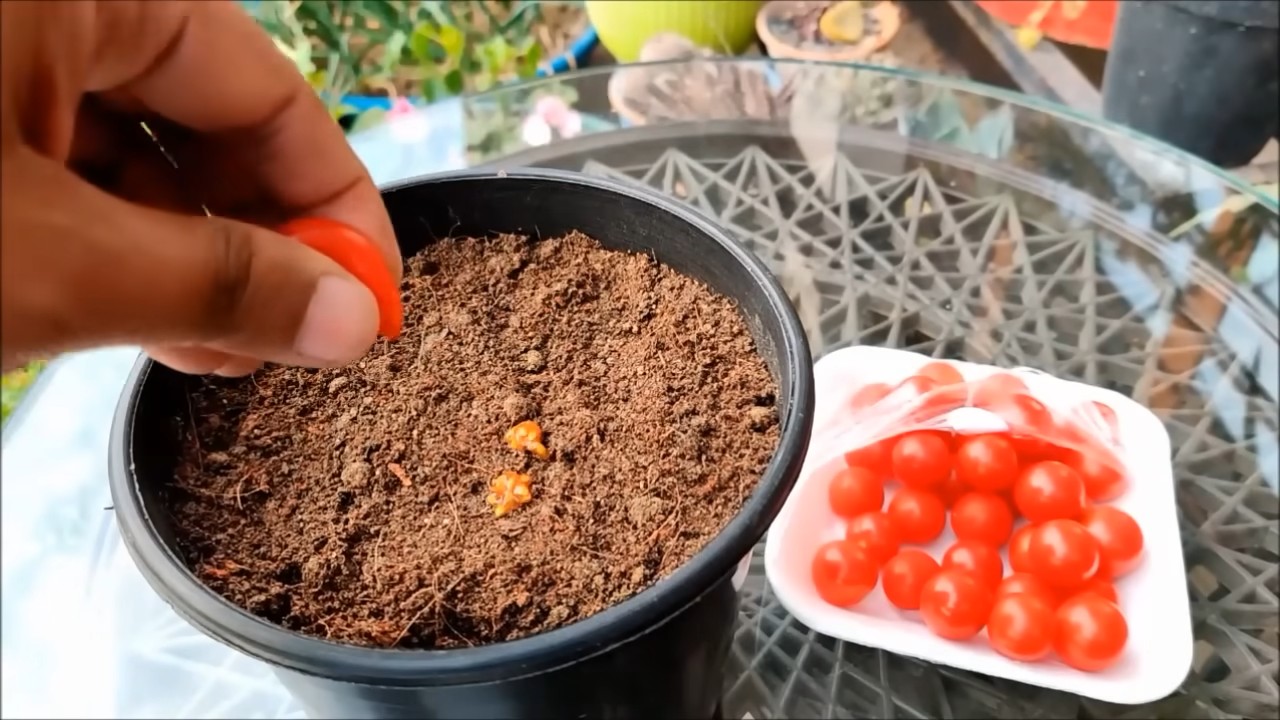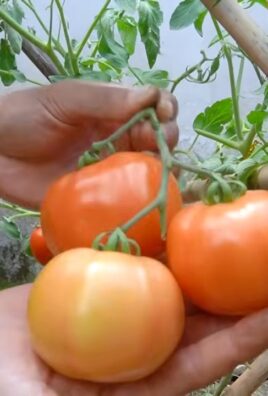Planting Cherry Tomatoes can feel like striking gold in your own backyard! Imagine plucking juicy, sun-ripened bursts of flavor straight from the vine – that’s the magic we’re unlocking today. For centuries, tomatoes, originating from South America, have been cultivated and cherished for their vibrant taste and nutritional benefits. From ancient Aztec gardens to modern-day balconies, the allure of homegrown tomatoes remains strong.
But let’s be honest, sometimes getting those perfect little red gems can be a bit tricky. Are you tired of lackluster store-bought cherry tomatoes that lack that intense, sweet flavor? Do you dream of a bountiful harvest but feel intimidated by the process? Well, fear not! I’m here to share some simple yet effective DIY tricks and hacks that will transform your planting cherry tomatoes experience from frustrating to fantastic.
This isn’t just about growing tomatoes; it’s about connecting with nature, enjoying fresh, healthy food, and experiencing the satisfaction of creating something beautiful and delicious with your own two hands. So, grab your gardening gloves, and let’s dive into the secrets of cultivating a thriving cherry tomato patch that will have you snacking on sunshine all season long!

Planting Cherry Tomatoes: A Beginner’s Guide to Sweet Success
Okay, so you want to grow your own cherry tomatoes? Awesome! They’re super rewarding, relatively easy to grow, and nothing beats the taste of a sun-ripened cherry tomato straight from your garden. I’m going to walk you through everything you need to know, from choosing the right variety to harvesting your bounty. Let’s get started!
Choosing Your Cherry Tomato Variety
First things first, let’s talk about varieties. There are tons of different cherry tomato types out there, each with its own unique flavor, size, and growth habit. Here’s a quick rundown of some popular choices:
* ‘Sungold’: These are incredibly sweet and have a beautiful golden-orange color. They’re a favorite for a reason!
* ‘Sweet Million’: As the name suggests, these produce a huge quantity of small, red, and very sweet tomatoes.
* ‘Black Cherry’: These have a rich, complex flavor and a deep, almost black color. They’re a bit more unique and definitely worth trying.
* ‘Grape Tomato’: These are oblong shaped, firm, and have a mild, slightly tangy flavor. They’re great for snacking.
* ‘Yellow Pear’: These are shaped like tiny pears and have a mild, sweet flavor. They add a fun visual element to your garden.
Consider your taste preferences and the space you have available when making your choice. Some varieties are more compact than others.
Gathering Your Supplies
Before we get our hands dirty, let’s make sure we have everything we need. Here’s a checklist:
* Cherry Tomato Seedlings: You can start from seed indoors 6-8 weeks before the last expected frost, or you can buy seedlings from a local nursery. I usually opt for seedlings because it’s easier!
* Potting Mix: Use a high-quality potting mix specifically designed for vegetables. Don’t use garden soil in containers, as it can become compacted and doesn’t drain well.
* Gardening Gloves: Protect your hands!
* Trowel: For digging holes.
* Watering Can or Hose: For watering your plants.
* Fertilizer: A balanced fertilizer formulated for tomatoes. I like to use an organic tomato fertilizer.
* Stakes or Cages: Cherry tomato plants can get quite large and need support. Stakes or cages will help keep them upright and prevent the fruit from touching the ground.
* Containers (if planting in pots): Choose containers that are at least 12 inches in diameter and depth. Bigger is better!
* Mulch: Straw, wood chips, or shredded leaves to help retain moisture and suppress weeds.
Planting Your Cherry Tomato Seedlings
Alright, let’s get to the fun part! Here’s how to plant your cherry tomato seedlings, whether you’re planting in the ground or in containers:
Planting in the Ground
1. Choose a Sunny Location: Cherry tomatoes need at least 6-8 hours of sunlight per day. Find a spot in your garden that gets plenty of sun.
2. Prepare the Soil: Dig a hole that’s twice as wide and as deep as the root ball of your seedling. Amend the soil with compost or well-rotted manure to improve drainage and fertility.
3. Remove the Seedling from its Container: Gently squeeze the sides of the container to loosen the root ball. Carefully remove the seedling, being careful not to damage the roots.
4. Plant the Seedling: Place the seedling in the hole, making sure the top of the root ball is level with the surrounding soil. You can even bury the stem a bit; tomatoes will grow roots from the buried stem, making for a stronger plant.
5. Backfill the Hole: Fill the hole with soil, gently firming it around the base of the plant.
6. Water Thoroughly: Water the plant deeply to help settle the soil and encourage root growth.
7. Add Support: Install a stake or cage to support the plant as it grows.
8. Mulch: Apply a layer of mulch around the base of the plant to help retain moisture and suppress weeds.
Planting in Containers
1. Choose the Right Container: Select a container that is at least 12 inches in diameter and depth. Make sure it has drainage holes.
2. Fill the Container with Potting Mix: Fill the container with high-quality potting mix, leaving a few inches of space at the top.
3. Remove the Seedling from its Container: Gently squeeze the sides of the container to loosen the root ball. Carefully remove the seedling, being careful not to damage the roots.
4. Plant the Seedling: Place the seedling in the container, making sure the top of the root ball is level with the surrounding soil. Again, burying the stem a bit is perfectly fine.
5. Backfill the Container: Fill the container with potting mix, gently firming it around the base of the plant.
6. Water Thoroughly: Water the plant deeply to help settle the potting mix and encourage root growth.
7. Add Support: Install a stake or cage to support the plant as it grows.
8. Place in a Sunny Location: Place the container in a location that gets at least 6-8 hours of sunlight per day.
Caring for Your Cherry Tomato Plants
Now that your cherry tomato plants are in the ground (or in containers), it’s important to provide them with the care they need to thrive.
* Watering: Water your cherry tomato plants regularly, especially during hot, dry weather. Aim to keep the soil consistently moist, but not waterlogged. Water deeply at the base of the plant, avoiding wetting the foliage, which can lead to disease. I usually water in the morning so the leaves have time to dry out during the day.
* Fertilizing: Fertilize your cherry tomato plants every 2-3 weeks with a balanced fertilizer formulated for tomatoes. Follow the instructions on the fertilizer package. You can also use a liquid fertilizer for a quick boost.
* Pruning: Pruning can help improve air circulation and encourage fruit production. Remove any suckers (the small shoots that grow between the main stem and the branches) that appear below the first flower cluster. You can also remove any yellowing or diseased leaves.
* Supporting: As your cherry tomato plants grow, they will need support to keep them upright. Tie the stems to stakes or train them to grow up cages. This will prevent the fruit from touching the ground and rotting.
* Pest and Disease Control: Keep an eye out for pests and diseases. Common pests include aphids, tomato hornworms, and whiteflies. Common diseases include early blight, late blight, and blossom end rot. Treat any problems promptly with appropriate organic or chemical controls. I prefer to use organic methods whenever possible. Neem oil is a great all-purpose solution for many pests and diseases.
* Mulching: Maintain a layer of mulch around the base of the plants to help retain moisture, suppress weeds, and regulate soil temperature.
Harvesting Your Cherry Tomatoes
The best part! You’ll know your cherry tomatoes are ready to harvest when they are fully colored, slightly soft to the touch, and easily pull away from the vine. The color will depend on the variety you planted.
* Harvest Regularly: Harvest your cherry tomatoes regularly to encourage continued production.
* Handle with Care: Cherry tomatoes are delicate, so handle them with care to avoid bruising.
* Store Properly: Store your cherry tomatoes at room temperature for the best flavor. You can also refrigerate them, but they may lose some of their flavor.
Troubleshooting Common Problems
Even with the best care, you might encounter some problems along the way. Here are a few common issues and how to address them:
* Blossom End Rot: This is caused by a calcium deficiency and results in a dark, leathery spot on the bottom of the tomato. To prevent blossom end rot, make sure your soil is well-drained and that you’re providing your plants with adequate calcium. You can add lime to the soil or use a calcium-rich fertilizer. Consistent watering is also key.
* Early Blight: This is a fungal disease that causes dark spots on the leaves. To prevent early blight, provide good air circulation around your plants and avoid wetting the foliage when watering. Remove any infected leaves promptly. You can also use a fungicide if necessary.
* Tomato Hornworms: These large green caterpillars can quickly defoliate your tomato plants. Handpick them off the plants and drop them into a bucket of soapy water. You can also use Bacillus thuringiensis (Bt), a natural insecticide, to control them.
* Aphids: These small, sap-sucking insects can weaken your plants. Spray them off with a strong stream of water or use insecticidal soap.
Enjoying

Conclusion
So, there you have it! Planting cherry tomatoes doesn’t have to be a daunting task. By following these simple steps and embracing this DIY trick, you’re setting yourself up for a bountiful harvest of sweet, juicy cherry tomatoes right in your own backyard or balcony. This isn’t just about growing tomatoes; it’s about connecting with nature, enjoying the fruits (or vegetables!) of your labor, and experiencing the satisfaction of creating something delicious from scratch.
Why is this DIY approach a must-try? Because it empowers you to take control of your food source, ensuring you’re consuming fresh, healthy produce free from unwanted chemicals. Plus, it’s incredibly rewarding to watch those tiny seedlings transform into thriving plants laden with vibrant red orbs. And let’s be honest, nothing beats the taste of a sun-ripened, homegrown cherry tomato!
But don’t stop there! Feel free to experiment with different varieties of cherry tomatoes. Try growing yellow pear tomatoes for a unique flavor and color, or perhaps some black cherry tomatoes for a touch of sophistication. You can also explore companion planting to enhance the growth and flavor of your tomatoes. Basil, marigolds, and carrots are all excellent companions for cherry tomatoes. Consider adding a trellis or cage to support your plants as they grow, especially if you’re growing indeterminate varieties that can become quite large.
Remember, gardening is a journey, not a destination. There will be successes and challenges along the way, but that’s all part of the fun. Don’t be afraid to get your hands dirty, learn from your mistakes, and adapt your approach as needed. The most important thing is to enjoy the process and celebrate your accomplishments, no matter how big or small.
We wholeheartedly encourage you to try this DIY trick for planting cherry tomatoes. It’s a simple, effective, and incredibly rewarding way to grow your own delicious produce. And once you’ve experienced the joy of harvesting your own cherry tomatoes, we’re confident you’ll be hooked!
We’d love to hear about your experiences! Share your photos, tips, and stories in the comments below. Let’s create a community of passionate gardeners who are dedicated to growing their own food and sharing their knowledge with others. Happy gardening!
Frequently Asked Questions (FAQ)
What is the best time to plant cherry tomatoes?
The ideal time to plant cherry tomatoes is after the last frost in your area. Cherry tomatoes are warm-season plants and are sensitive to cold temperatures. Planting them too early can stunt their growth or even kill them. A good rule of thumb is to wait until the soil temperature reaches at least 60°F (15°C). You can check the soil temperature using a soil thermometer. If you’re starting your tomatoes indoors, you can begin the process 6-8 weeks before the last expected frost. This gives the seedlings a head start and allows them to establish a strong root system before being transplanted outdoors.
How much sunlight do cherry tomatoes need?
Cherry tomatoes require at least 6-8 hours of direct sunlight per day to thrive. Sunlight is essential for photosynthesis, the process by which plants convert light energy into chemical energy for growth. Choose a planting location that receives ample sunlight throughout the day. If you’re growing tomatoes in containers, you can move them around to ensure they get enough sunlight. If you live in a particularly hot climate, some afternoon shade can be beneficial to prevent the plants from overheating.
What kind of soil is best for cherry tomatoes?
Cherry tomatoes prefer well-draining soil that is rich in organic matter. The soil should be slightly acidic, with a pH between 6.0 and 6.8. Before planting, amend the soil with compost, aged manure, or other organic materials to improve its fertility and drainage. Avoid heavy clay soils, as they can become waterlogged and suffocate the roots. If you have clay soil, consider growing your tomatoes in raised beds or containers with a well-draining potting mix. You can also add perlite or vermiculite to the soil to improve drainage.
How often should I water my cherry tomatoes?
Water cherry tomatoes deeply and regularly, especially during hot, dry weather. Aim to water at the base of the plant to avoid wetting the foliage, which can increase the risk of fungal diseases. The frequency of watering will depend on the weather conditions, soil type, and size of the plant. As a general guideline, water when the top inch of soil feels dry to the touch. Avoid overwatering, as this can lead to root rot. Mulching around the plants can help to retain moisture in the soil and reduce the need for frequent watering.
Do cherry tomatoes need fertilizer?
Yes, cherry tomatoes benefit from regular fertilization. Use a balanced fertilizer that is specifically formulated for tomatoes. Follow the instructions on the fertilizer package for application rates and frequency. You can also use organic fertilizers, such as compost tea or fish emulsion. Fertilize your tomatoes every 2-3 weeks during the growing season. Avoid over-fertilizing, as this can lead to excessive foliage growth at the expense of fruit production.
How do I prevent pests and diseases on my cherry tomatoes?
There are several steps you can take to prevent pests and diseases on your cherry tomatoes. First, choose disease-resistant varieties whenever possible. Second, practice good garden hygiene by removing any dead or diseased leaves and debris from around the plants. Third, water at the base of the plant to avoid wetting the foliage. Fourth, provide adequate spacing between plants to improve air circulation. Fifth, inspect your plants regularly for signs of pests or diseases. If you find any pests, you can try hand-picking them off the plants or using insecticidal soap or neem oil. For diseases, you can try using a fungicide. Companion planting with basil or marigolds can also help to deter pests.
When are cherry tomatoes ready to harvest?
Cherry tomatoes are typically ready to harvest when they are fully colored and slightly soft to the touch. The exact color will depend on the variety you are growing. Gently twist or snip the tomatoes from the vine. Harvest your tomatoes regularly to encourage continued production. Overripe tomatoes can become soft and mushy, so it’s best to harvest them when they are at their peak ripeness.
Can I grow cherry tomatoes in containers?
Yes, cherry tomatoes are well-suited for container gardening. Choose a large container that is at least 12 inches in diameter and has drainage holes. Use a well-draining potting mix and provide adequate sunlight and water. You may also need to stake or cage your plants to support them as they grow. Container-grown tomatoes may require more frequent watering and fertilization than those grown in the ground.
What are some common problems when planting cherry tomatoes?
Some common problems when planting cherry tomatoes include blossom end rot, cracking, and pests. Blossom end rot is caused by a calcium deficiency and can be prevented by ensuring the soil is properly amended with calcium and by watering regularly. Cracking is caused by fluctuations in soil moisture and can be prevented by providing consistent watering. Pests such as aphids, whiteflies, and tomato hornworms can be controlled with insecticidal soap, neem oil, or hand-picking.
How do I save seeds from my cherry tomatoes?
Saving seeds from your cherry tomatoes is a great way to preserve your favorite varieties and save money. Choose ripe, healthy tomatoes from disease-free plants. Squeeze the seeds and pulp into a jar and add a little water. Let the mixture ferment for 3-4 days, stirring occasionally. This process will help to remove the gelatinous coating from the seeds. After fermentation, rinse the seeds thoroughly and spread them out on a paper towel to dry. Once the seeds are completely dry, store them in an airtight container in a cool, dark place.




Leave a Comment